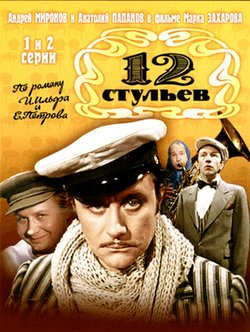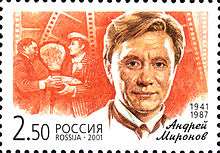The Twelve Chairs (1976 film)
| The Twelve Chairs | |
|---|---|
 | |
| Based on | The Twelve Chairs |
| Written by |
Mark Zakharov Evgeniy Shvarts |
| Directed by | Mark Zakharov |
| Starring |
Andrei Mironov Georgy Vitsin Anatoli Papanov Aleksandr Abdulov Tatyana Pelttser Lidiya Fedoseyeva-Shukshina |
| Country of origin | Soviet Union |
| Original language(s) | Russian |
| Cinematography |
Vladimir Osherov Georgi Rerberg Dmitri Surensky |
| Editor(s) |
T. Aksyonova Nina Osipova |
| Distributor | Studio Ekran |
| Release | |
| Original release | 1976 |
The Twelve Chairs (Russian: 12 стульев) is 1976 four episode musical television film directed by Mark Zakharov based on the 1928 novel of the same name by Ilf and Petrov.[1]
It is the second full length adaptation of the novel in the Soviet Union (the first was directed by Leonid Gaidai[2]) and is the sixth one in the world.
Plot
The film takes place in 1927 from April to October in the Russian cities of Stargorod, Moscow, Vasyuki, Pyatigorsk, Vladikavkaz, Tbilisi, and Yalta.
The quiet life of registrar Ippolit Matveyevich Vorobyaninov is rocked by the sudden death of his mother-in-law Claudia Ivanovna, who admits that she sewed her diamonds into the seat of one of the twelve chairs belonging to their former living room set in order to hide it from Soviet forces, who had been confiscating treasures from everyone.
Vorobyaninov decides to track down the treasure. Before he can begin his quest, Ippolit Matveyevich meets a young swindler named Ostap Bender who coerces him into agreeing to help in the search in exchange for a percentage of the profit. Unfortunately, the town priest Father Fyodor also learns of Claudia Ivanovna's secret as part of her confession and decides to find the chair himself. Bender dreams of using the profits to move to Rio de Janeiro, which he believes to be the greatest place in the world.
The companions go on the hunt for the chairs across the whole country, encountering many unique and interesting characters, and competing against each other along the way. In the end, they find eleven out of the twelve chairs and return to Moscow without finding the treasure. Somehow, Bender manages to track down the last missing chair and informs Ippolit Matveyevich, whom he has taken to calling Kisa, about this before he goes to sleep. Because they have inspected all the other chairs and found nothing, both know that the treasure is hidden in this last chair. Kisa decides to seize the treasure for himself and kills the sleeping Ostap by cutting his throat with a straight razor. However, Vorobyaninov fails to retrieve the treasure because the Railroad Club caretaker had accidentally discovered the diamonds in the chair and "Comrade Krasilnikov", the club's manager, has already built a new club with the money.

Cast
- Andrei Mironov as Ostap Bender
- Georgy Vitsin as Bezenchuk
- Anatoli Papanov as Vorobianinov
- Aleksandr Abdulov as engineer Schukin
- Tatyana Pelttser as Madame Petukhova
- Lidiya Fedoseyeva-Shukshina as Madame Gritsatsuyeva
- Lyubov Polishchuk as dancer
- Mark Zakharov
- Vsevolod Larionov as Absalom Iznuryonkov
- Vera Orlova as Yelena Stanislavovna Bour
- Eduard Abalov
Themes and analysis
The Twelve Chairs, much like its source material, is a social critique of society, opining on themes such as religion, culture, economic policy, morality and the transformation of Russia under communism. Vorobianinov represents the old guard of Russians of the Russian Empire, while Bender himself is the epitome of the new Russian people under the rule of the Community Party.
References
- ↑ ВокругТВ. Бендер на экране и в жизни
- ↑ The very first partial film adaptation in the USSR was made by Alexander Belinsky who shot the television film "The Twelve Chairs" in 1966; the film was not a full adaptation of the novel, but merely an adaptation of some chapters
External links
- 12 stulyev on IMDb